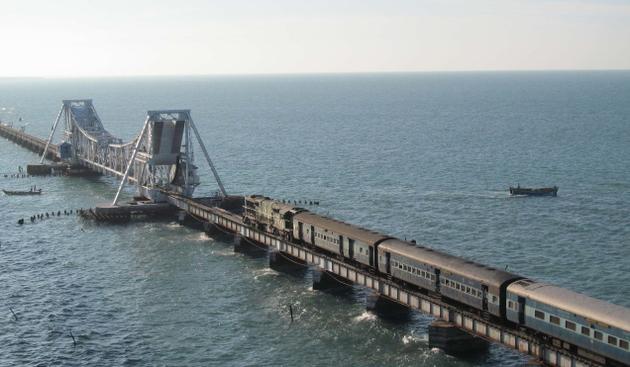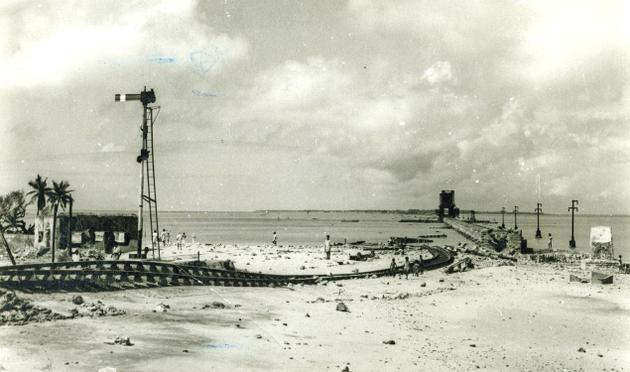On the centenary of the Pamban Rail Bridge, which connects Rameswaram to the Indian mainland, a look at its history and significance.

It’s a sight that’s been playing in an infinite loop for about 100 years now, since the Pamban Rail Bridge opened in 1914. The bridge, which until 2010 was India’s longest sea bridge — the Bandra Worli Sea Link in Mumbai having now bagged that title — connects the island of Rameswaram to the Indian mainland. Often referred to as the economic and spiritual lifeline of this region, the bridge celebrated its centenary early this week. In the midst of the revelries, questions concerning the future of the bridge against its maintenance as a heritage site came to the fore. While the two sides objectively argue their cases, a subjective detour back in time might be just what the doctor ordered.
In the annals of the Indian Railways, one man’s name is synonymous with the Pamban Rail Bridge. Fondly known as the Metro Man of India, E Sreedharan, achieved the near-impossible task of restoring the Pamban Bridge to a fully operational state in a mere 46 days, after it was devastated by a cyclone on December 23, 1964. Reminiscing about that time Sreedharan says, “The damage to the rail bridge was so severe that it wasn’t considered worth restoring. The government was already planning to construct a road bridge connecting Rameswaram to the mainland. However, SK Patil, the then union railway minister, knew the importance of Rameswaram as a pilgrimage centre and decided to repair the bridge.”

Elaborating on those months of backbreaking work, Sreedharan says, “Of the 146 spans in the bridge, 124 had been damaged or washed away. We urgently needed metre gauge girders (support beams) to build the bridge. We sourced them from states as far as Assam and Rajasthan, but there was still a shortage. Thankfully, the fishermen in Pamban came to our rescue. They had spotted many girders that had been swept away in the cyclone and were lying 40 feet below, on the seabed. We salvaged those and worked at breakneck speed to complete the restoration. It used to take us three days to launch one girder. Soon we were launching a girder a day. On the last two days, we launched eight girders.” And the results were there for all to see. The project was estimated to be completed in six months, Sreedharan and his team accomplished it in 46 days.
But there’s an altogether personal history of sacrifice that is intertwined with Sreedharan’s association with the bridge. He says, “My wife was pregnant with our daughter when I was informed about the cyclonic damage to the Pamban Bridge. I was on Christmas leave at my hometown in Pattambi, while my wife was at her maternal home in Ponnali. I didn’t have the time to meet her before heading to Pamban and commencing work on the bridge. A few weeks later, I came to know that we had been blessed with a baby girl. However, I was unable to go see her as my presence was needed at the bridge at all times during the ongoing restoration work. Finally, after we had put the bridge back in operation, I was able to go home and see my daughter for the first time.”
The legacy of the Pamban Bridge and the need for its continued service is fully understood by engineers today. In 2006, a contingent from IIT Madras led by professor Kalyanaraman was entrusted with instrumenting the bridge. Many new members (structural elements used to brace bridges and buildings) were added to it and it was strengthened at the bottom as well.
Recounting his memories of the bridge, Dr S Arul Jayachandran, from the Structural Engineering Laboratory at the Department of Civil Engineering, IIT Madras says, “I was about four years old when the cyclone struck. My hometown, Madurai, was bathed in a pall of gloom. A few months later, I undertook the first rail journey of my life. It took me across the Pamban Rail Bridge. I remember how everybody peeped out of their windows in the train when it crossed the bridge on a particularly low-tide day. We were stunned and delighted to know that this was the same bridge that had once been ravaged by the cyclone.”
For Jayachandran, it was merely the beginning of a lifelong love affair. In 1983, for his undergraduate thesis, he presented the concept of an alternate bridge connecting Rameswaram to the mainland. He is now finalising a technical report based on a study that he had carried out on the Pamban Rail Bridge in December 2013. He says, “The 100-year-old bridge has a place of pride in the hearts of many generations of Indians. We consider it a part of our historical identity. From a purely conservationist point of view, it is a thing of beauty and must be protected. From a scientific viewpoint, the safety of the passengers is paramount. The bridge has withstood the test of time for more than a century. I am optimistic that it will remain so for another century.”
source: http://www.thehindubusinessline.com / Business Line / Home> Features / by Bijoy Bharathan / February 28th, 2014